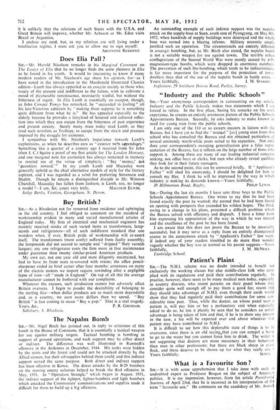The Napalm Bomb
Sut,—Mr. Nigel Birch has pointed out, in reply to criticisms of this bomb in the House of Commons, that it is essentially a tactical weapon for use against military targets. Tactical bombing is bombing in support of ground operations, and such support may be either direct- or indirect. The difference was well illustrated in Runstedt's offensive in the Ardennes in December, 1944. His tanks were hidden by the mists and the forest and could not be attacked directly by the Allied airmen, but their oil-supplies behind them could, and this indirect support served the same purpose. Both direct and indirect support has been effective in Korea. The direct attacks by the B-29 bombers on the moving enemy columns helped to break the Red offensive in May, 1951. In " Operation Strangle," wh:ch began in August, 1951,. the indirect support of the fighters, fighter-bombers and light bombers which attacked the Communists' communications and supplies made it difficult for them to build up it big offensive.
An outstanding example of such indirect support was the napalm attack on the supply-base at Suan, south east of Pyongyang, on May 8th, 1952, when hundreds of supply buildings were destroyed and the whole base was turned into a blazing inferno. Military necessity ,amply justified such an operation. The circumstances are entirely different in strategic bombing, but, as Mr. Birch also stated, the napalm bomb is not a suitable weapon for use against towns. The terrible urban conflagrations of the 'Second World War were mostly caused by 4-1b. magnesium-type bombs, which were dropped in enormous numbers. The prevention of such fire-bombing, which tends to be indiscriminate, is far more important for the purpose of the protection of town- dwellers than that of the use of the napalm bomb in battle areas.—










































 Previous page
Previous page